This is a much larger section because of so many surviving records.
Lengthy lists and other details on this page are often provided in downloadable PDFs.
Church Records (mainly 19th century) are detailed separately on the next page (see left hand column).
See also many 19th century records listed in Byers graves in Co. Down.
On this page:
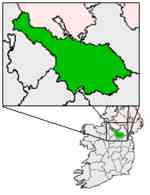
Co. Cavan in the context of Ireland.
1810 Subscribers' list for McKenzie poems
Andrew McKenzie (1780-1839), known as the “Bard of Dunover”, was a rhyming weaver poet from Dunover, near Ballywalter in Co.Down. He also wrote under the pen-name of Philip McClabber.In 1810 his Poems and Songs on Different Subjects was published in an edition printed by Alexander Mackay, News-Letter Office, Belfast. The volume’s preface is dated October 1810.
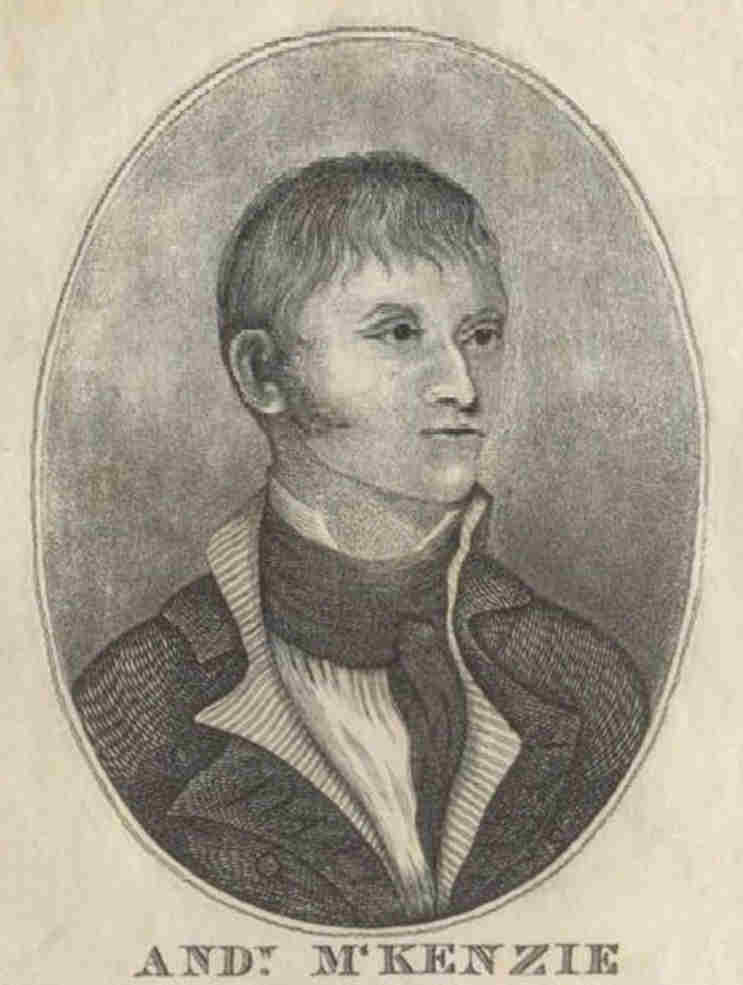
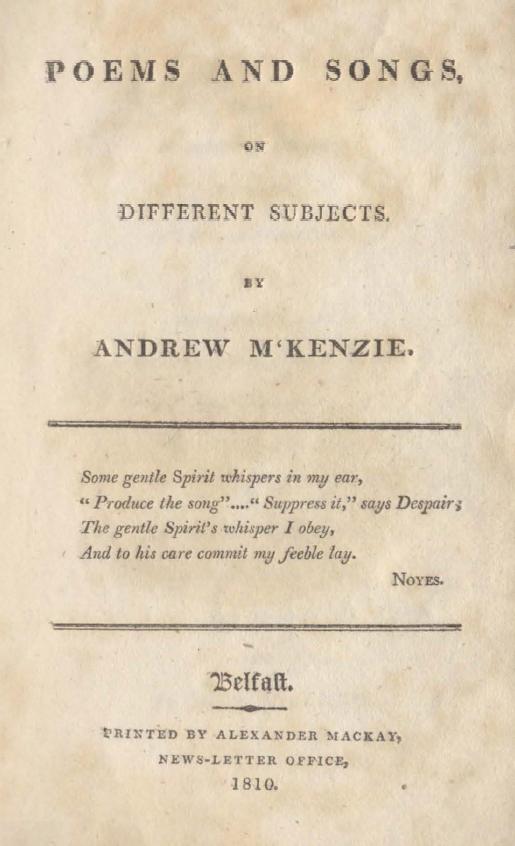
Above: Title page of McKenzie's collection which is available to read online through the University of Ulster's Ulster Poetry Project.
Top right: McKenzie's portrait from the collection.
William Byers, Belfast
John Byers, Dunover
David Byers, Ballyblack
Samuel Byers, Ballywhisken
Francis Byers, Ballygannaway
William Byers, Greyabbey
Robert Byers, Ballybolly
James Byers, Greyabbey
Andrew McKenzie is buried in Belfast’s Shankill graveyard and his grave has an epitaph written by another poet, the Belfast-based bookseller William McComb (1793-1873):
Here lies beneath this little mound of earth
A child of genius and a man of worth;
The winds of heaven awoke his rustic lyre,
And tuneful nature breathed from every wire.
The world approved his song, but help denied,
He lived unaided and neglected died.
Births, Deaths and Marriages in the Belfast News-Letter, 1801-1863
The Linenhall Library in Belfast has a card index file which contains an alphabetical listing of Birth, Death and Marriage insertions in the Belfast News-Letter from 1801 to 1863.
The following PDF provides a transcription of all the insertions relating to Byars and Byers in that index. It should be possible to identify those newspaper insertions through the online subscription site British Newspaper Archive.
When this BL collection is searched for Byers it produces 90 such entries, though only 17 of those 90 refer to the period listed by the Linen Hall Library index which has 25 for the same period.

|
BYARS and BYERS in the Linen Hall Library.pdf Size : 89.006 Kb Type : pdf |
1821 Census for Co. Cavan
A copy of much of the 1821 Co. Cavan census was found in the 1950s in Cavan town - sadly Killinkere was not amongst the surviving records. A microfilm copy is in the Cavan County Library and this was consulted for the following PDF listing of persons named Byers. A double-checking of these facts was carried out by referring to the LDS microfilm copies of the census (numbers given below).
The 1821 Census has since become available online, thanks to Debbie Annandale.
The order of reporting in the census meant that, in most cases, sons were listed first, then the daughters. My reporting of this information (see PDF below) replaces that original ordering with a chronological one.
1821 Census details (i.e. what has actually survived):
Castlerahan, Castleterra
Crosserlough, Denn, Drumlumman
Drung, Kilbride
Kilmore, Kinawley
Lavey, Lurgan, Mullagh, Munterconnaught
LDS Film 0597154
LDS Film 0597155
LDS Film 0597156
LDS Film 0597157
LDS Film 0597158
Please see this PDF:

|
Cavan 1821 Census.pdf Size : 152.877 Kb Type : pdf |
Arms registered in 1832 in Co. Cavan
COUNTY OF CAVAN / A LIST / of the / Arms Registered / with the / Clerks of the Peace, / For said County, / To April Sessions, / 1833
Only one reference to BYERS, registered at Cavan on 3 July 1832:
Robert Byers, residing at Tievanaman [Tievenaman] in the parish of Killinkere and Barony of Castleraghan, possessed 2 guns and 1 sword.
He had no pistols, blunderbusses or bayonets.
RH pic: Sporting gun, London, c.1830
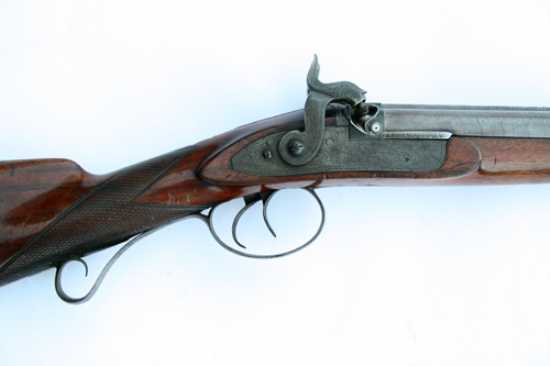
Killinkere Parish Tithe Applotments, 1834
The 1823 Tithe Applotment Act allowed a tithe or tax to be paid in money instead of in goods. It was calculated on an estimate of what the land could produce, based on an average of the seven years up to 1 November 1821.
The Tithe Applotment books cover 1823 to 1837. For each townland in a given parish they provide the names of the occupiers, the acreage and quality of their holdings, the valuation of the land and the amount of tithe to be paid.
Apart from Killinkere (see below), I’ve still to check the actual Tithe Applotments in PRONI and, likewise, the Townland Valuation of 1828-40, which was primarily a valuation of land but included houses, initially those with an annual value of £3 or more. From 1838 this was increased to £5.
Killinkere Parish Tithe Applotments - 1834
What a pity that some of the townland records for Killinkere Parish are missing, viz. Lissanymore, Gallon, Corratinner, Beagh Glebe, Togher, Termon, Derryhum, Carrickeeshill and Greaghnacunnia.
The following are the townlands which include Byers occupiers.
Coranedan [Corraneden]
William Byers
Joseph Byers
Jas. Sr. Byers
Jas. Jr. Byers
Robert Byers
Drumagolan
John Byers
John Byers
Drumollard [Drummallaght]
James Byers
Killaduffe [Killyduff]
Robert Byers
Lateaster
John Byers
Lisacoppel [Lissacapple]
John Byers
Teivanaman [Tievenaman]
Robt Byers
John Byers
Joseph Byers
Byers references in the Farnham Estate Papers, Co. Cavan
The National Library of Ireland holds the papers from the Farnham estate and a complete listing has been made available online.
The PDF below is a listing of the specific Byers references and is helpful in pinpointing particular groupings of families. The actual documents (which I've not yet seen) may shed further light on those individuals.
Pic of Farnham House, built c.1810 and designed by Francis Johnston.
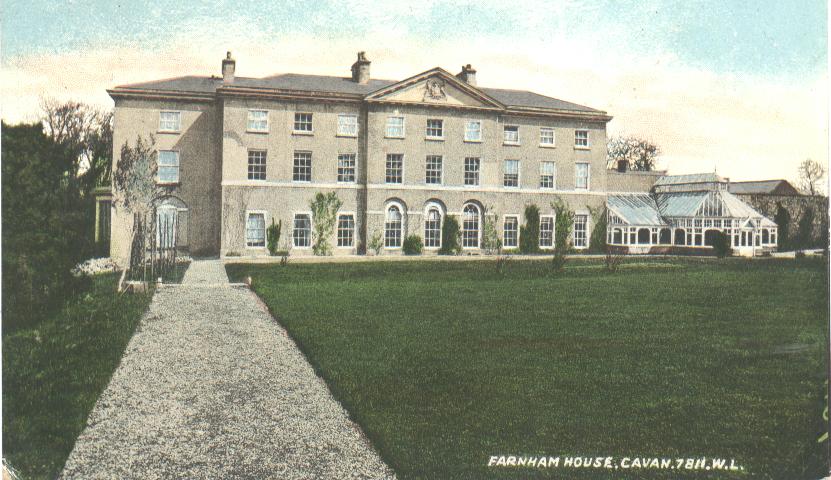

|
Byers in the Farnham Papers.pdf Size : 53.889 Kb Type : pdf |
Name Check for Tithe Applotments and Griffith's Valuation
The first full-scale valuation of property in Ireland was the Primary Valuation undertaken by Sir Richard Griffith and published between 1848 and 1864. His Valuation records every landowner and householder in Ireland in a period shortly after the famine.
The main difference between the Tithe Applotment Books and Griffith’s Valuation is that all householders were listed in Griffith’s.
Remember that the types of acres used in each, the Irish and English acre, are different. This will account for difference in size of land held by a family from one valuation to the other if they appear in both. Remember also the fact that houses of less than £3 annual value were included up to the year 1831 and excluded from that point forward; and those with an annual value of £5 were included up to 1836 and excluded from then on.
For Griffith’s Valuation, the number after G indicates the number of householders with that name in a parish or barony.For the Tithe Applotment Books, T indicates that that name occurs at least once in the parish in question.
The following PDF records the parishes in which Byers families were to be found for Counties Cavan, Down, Antrim, Derry, Armagh, Fermanagh and Donegal:

|
Name Check.pdf Size : 147.788 Kb Type : pdf |
Griffith's Valuations for Byers families in Cavan and Down
Cavan and Down are the two Ulster counties with the greatest number of Byers families.
Griffith's Valuation gives the following numbers for households of Byers/Byres/Biars/Byars by county or city:
Down
Belfast city
Armagh
Fermanagh
Monaghan
25 (all spelt Byers)
7
5
4
3
Tyrone
Antrim
Sligo
Cork city
2 (all spelt Biars)
2
1
1
Below is the typical information given for two Killinkere townlands with Byers families.
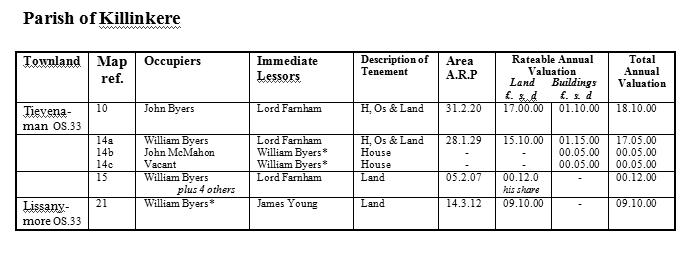

|
Griffith's Valuations.pdf Size : 217.886 Kb Type : pdf |
The following Byers families are included in Co. Down Valuations:
Byers
Byers
Byers
Byers
Byers
Byers
Byers
Byers
Byers
Byers
Byers
Byers
Byers
Byers
Byers
Byers
Byers
Byers
Byers
Byers
Alexander
Eliza
Isabella
James
James
James
James
James
John
John
John
John
Robert
Robert
Robert
Robert
Thomas
William
William
William John
Little Back, Portaferry
Ean Hill St. Holywood
Ballywaddan
Ballyblack
Ballyblack
Ballywaddan
Cromac, Ballymacarret, Newtownards Road
Maghereagh
Dunover
Gray's Lane, Holywood
Village of Grey Abbey
Village of Grey Abbey
Ballyboley
Ballyboley
Maghereagh
Tullycarnan
Newcastle Street,Kilkeel
Ballyboley
Ballyboley
Tullyear
Ballyphilip
Holywood
Ardquin
Grey Abbey
Grey Abbey
Ardquin
Knockbreda
Kilkeel
Ballywalter
Holywood
Grey Abbey
Grey Abbey
Grey Abbey
Grey Abbey
Kilkeel
Ballyphilip
Kilkeel
Grey Abbey
Grey Abbey
Seapatrick
James and Mary Byers - poisoners, 1831
Belfast News-Letter Tuesday 11 October 1831
EXECUTION OF BYERS AND HIS WIFE FOR MURDER
Thursday, James Byers and his wife, Mary Steel, were executed in Glasgow, for the murder and robbery of James Martin [an elderly uncle], in March last. It will be remembered that these criminals were found guilty of administering a large quantity of laudanum to the deceased, mixed with his liquor, in a spirit-cellar in High-Street [Glasgow].Since the condemnation of the prisoners, the female made a full confession of her guilt, but her husband denied all knowledge of the transaction.
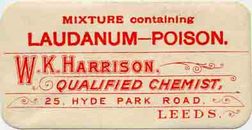
The female acknowledged having robbed Martin in the house in which they lodged, during which time her husband held the candle, and that he afterwards got a share of the booty.
At eight in the morning the Magistrates entered the hall, and the prisoners were brought up. Nothing could exceed the calm firmness of the female, who was an extremely good looking woman, and was neatly dressed.
After partaking of a glass of wine each, they were conducted to the scaffold by their friends, where Byers made a confession of his guilt, and that he had received some of the money. It is said that the whole plan of the murder and robbery was devised by his wife’s mother.
Byers, since the condemnation, had no desire to see his wife, and their behaviour to each other on the scaffold strongly countenanced this – there, if they did notice each at all, the recognition was very slight. When the preparations had been completed the signal was given and the drop fell. After hanging the usual time, the bodies were carried to the College for dissection.
They had lodged in Steel Street, Glasgow. “On the forenoon of March 10th, James and Mary Byers, together with another lodger, Agnes Cairnie, as well as John Martin, entered the shop of James Rennie, publican, in the High Street. There, according to Agnes, the couple plied Martin with porter from a tumbler. As a consequence he quickly fell into something akin to a stupor and required assistance back to the lodgings.”
Martin died “just before 6am on 11th March with the result that both James and Mary Byers were apprehended and charged with murder and theft.” In fact, “Mary Byers was found in Glasgow, but James had managed to make his way back to Belfast, where he was apprehended and brought back to Glasgow.”
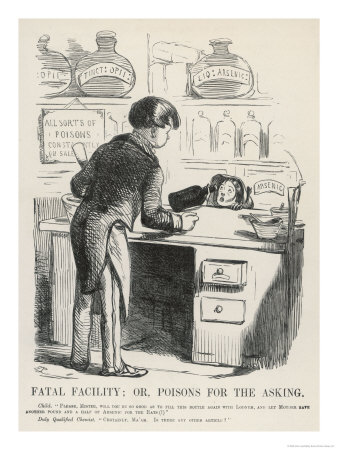
A shop assistant, John Lamont, gave evidence that Mary Byers had bought two pence worth of laudanum on Tuesday 10 March.
Alexander Milson gave evidence that Mary had also bought a further penny’s worth of laudanum from his brother’s chemist shop in Glasgow’s High Street.
Margaret Byers (1832-1912) and Rev. John Byers
Margaret Byers (pictured below, c.1885) founded what became Victoria College, Belfast, in 1859 as the Ladies’ Collegiate. She became renowned as a pioneer of women’s education, a business woman, philanthropist and a suffragist.Brief biographies are online at the Dictionary of Ulster Biography and at Ulster History. There’s also a comprehensive book about her: Margaret Byers Pioneer of Women's Education and Founder of Victoria College Belfast, by Alison Jordan (QUB Institute of Irish Studies, no date).
She was born Margaret Morrow, the fourth child and only daughter of Andrew Morrow, a farmer and flax mill owner in Rathfriland, Co. Down.
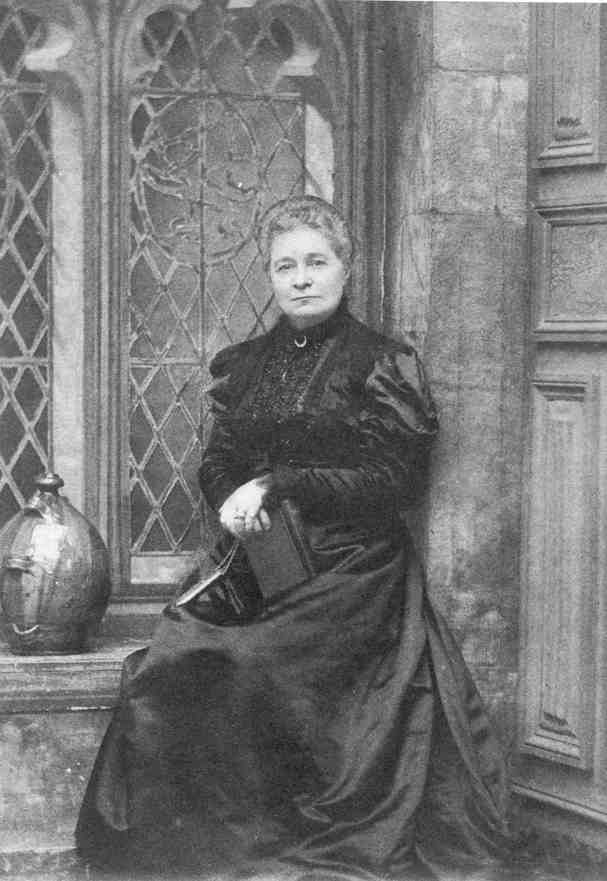
Andrew was a Presbyterian elder. He died when Margaret was eight years of age and she was sent to live with two uncles in Stoke-on-Trent.
She returned to Co. Down to marry a Byers, the son of another farmer and flax merchant just 10 miles away in Co. Armagh.
Rev. John Byers (1830-1853) had studied at Glasgow University (BA 1846, MA 1847) and then Princeton University, New Jersey, USA. The American Board of Missions commissioned him as a missionary to China.
The couple married on 24 February 1852 at Clonduff Presbyterian Church (three miles outside Rathfriland heading towards Castlewellan) which had been built just 10 years earlier.
They moved to Shangai where John became gravely ill. The family (there was now a baby boy called John) sailed back to New York round Cape Hope but Rev. John died just eight days before landfall. He is buried in Greenwood Cemetery, New York.
These are the Rev. John Byers' antecedents. See more information at thePeerage website.
Samuel Byers (dates unknown) lived at Mowhan House, Mowhan, Co. Armagh.
His son Samuel Byers (1790 - 16 May 1864) married Susan Maclean (c.1797 - 19 May 1873) in 1817.
They lived at Mowhan House, Mowhan, Co. Armagh.
Samuel and Susan had the following family:
George Byers (1824 - 14 October 1907) married Rachel Holland and emigrated to Australia
Susan Byers (1827 - ?)
Rev. John Byers (5 June 1830 - 1853) married Margaret Morrow; died at sea
Mary Anne Byers (9 August 1832 - before 1840)
Sarah Nickley Byers (24 August 1834 - ?) married Matthew Holden
Jane Elizabeth Byers (15 November 1836 - ?) married Robert Fisher on 19 December 1856
Samuel Byers (3 October 1838 – 11 March 1922) married Elizabeth Mandale, then Jane Halliwell Dempster; Land Commissioner and JP for Co. Armagh
William Byers (1842 – 6 April 1927) married Sarah Fisher, then Isabella Mandale; Deputy Lieutenant and JP for Co. Armagh; High Sheriff of Co. Armagh in 1916. Lived at Mill Farm, Mowhan.
Daniel Byers (1844 - ? died young)
Byers Court Case, Virginia, Co. Cavan, 1851
The Anglo-Celt 31 July 1851
VIRGINIA PETTY SESSIONS (From a Correspondent) July 23rd, 1851
A case of considerable interest came on for hearing this day before the presiding magistrate Mr. NIXON.
The charge, which was one of obtaining money under false pretences, was brought by David PETRIE, sewing agent of the firm of Wallace and Co., of Glasgow, against Samuel BYERS, a late agent of the same firm. The facts of the case as deposed to by the witnesses are these:
James WILSON, an agent of the Messrs. Wallace, residing in Ballyduff, received orders from his employers to send his collections of finished work to BYERS to Virginia, that they might be forwarded thence to Glasgow.
His last remittance was a bag (produced) containing about one hundred pieces, on each of which were imprinted two marks, the first an indelible one, affixed originally in Glasgow before the goods were forwarded to Ireland, and the second in plain ink, denoting the price paid by WILSON to the country girls for the execution of the needle-work.
During the time that this bag was in Byers’s possession he had been very unexpectedly replaced by Petrie, an agent sent over from Glasgow, and commissioned to take up such work belonging to the firm as Byers had given out and paid for.
This he accordingly proceeded to do, and received from Byers a considerable number of pieces amongst which he alleged were those in question. It appears also that the prices affixed to the pieces by Wilson in each case had been erased, and a higher amount substituted, which amount Petrie swore Byers received from him.
The Plaintiff, Petrie, who was not represented by attorney, rested his case on the identity which he and the witness Wilson fully established between the pieces received by Byers and those paid for by himself.
The defence set up by Mr. HARMAN was, that the delivery of the parcel to Byers had not been proved, and that the evidence adduced did not sustain the charge of false pretences.
The magistrate, however, very properly overlooked the legal informalities of the case and bound over Wilson and Petrie in sums of £20 each to prosecute at the next quarter sessions.
[We may here take the opportunity of remarking that the sprigging system, when carried on by young men exhibits in almost every direction many deplorable results. This journal has already recorded instances of a gross abuse of the discretionary power which the agents possess with regard to the remuneration of the poor working females. In Virginia, however, the most respectable can testify to the growth of a more lamentable evil – the frequent corruption of these poor creatures in whose breasts stern want has left but a feeble flickering of virtue. That town has latterly been blessed by a set of heartless "roués" of this class whose cruel extortations were made to furnish the means of extravagance and licentiousness. Their leader, a fellow of the name of _______ eloped lately with a short career of the most audacious vice, deeply involved with his employers and owing considerable sums to all on whom he succeeded in imposing. Such instances may, however, have the good effect of teaching Messrs. Robinson and Wallace the propriety of appointing females, or at least married men as their agents.]
Two more Byerses in court, 1876
Cavan Weekly News 4 February 1876
VIRGINIA PETTY SESSIONS – THURSDAY.
(Before Messrs. SANKEY, WARING, and MORTIMER.)
Sub-constable J. B. BRADSHAW v. Robert BYERS for being drunk.
Fined 5s. and costs.
Sub-constable Michael M’CORMACK v. Joseph BYERS, for same offence.
Fined 5s. and costs.
Registry Office Records
Monaghan Registrar’s Office
Date of marriage: 6 February 1857
Name & Surname Age Condition Rank/Profession Residence Father’s Name/Profession
Robert Byers Full Age Bachelor Farmer * Drumcaw, Alexander Byers, farmer Parish of Donagh
Catherine Ross Full Age Spinster - Drumcaw, Michael Ross, officer Parish of Donagh
The witnesses were William Blackburn and William Smyth
* Writing is indistinct
Byers Deaths registered in Dublin between 1864 and 1879
Civil registration of all deaths began on 1 January 1864. They were published as indexes for each year by the General Register Office in Dublin. From the details given in the index it is possible to request an actual certified copy of the death certificate.
Please note that the given ages (frequently in “round figures”) are often quite unreliable, whether through Pension subterfuge, vanity, ignorance or guesswork. Where the age was less than 1 year it was recorded as 0.
These records were searched for all references to Byers and to Ney.
The years 1864–1869 were also searched for any trace of a Joseph McIlwaine.
This was Jane’s father (Jane married widower Robert Byers, my great grandfather, in 1872) and he was described as “The late Joseph …” in her marriage certificate. He was similarly described in Anne McIlwaine’s marriage certificate of 1866 – “The late Joe …”. Nothing was found – the presumption now being that he probably died pre-1864.
The records revealed that my great grandfather, Robert Byers, died from diabetes on 30 November 1877 at his home in Rooskey. His death was registered “in the District of Cootehill in the Union of Cootehill in the Counties of Cavan and Monaghan”. His widow, Jane, remarried the following year.
The complete listing of Byers deaths from 1864 to 1879 is in this PDF:

|
Civil Records - Deaths.pdf Size : 202.834 Kb Type : pdf |
Byers Marriages registered in Dublin from 1845 to 1872
Civil registration of all non-Catholic marriages began in Ireland on 1 April 1845. They were published as indexes for each year by the General Register Office in Dublin.
These indexes were hand-written up to, and including, 1863. From the details given in the index it is possible to request a copy of the marriage certificate. If the name of the other spouse is known, this too ought to be indexed and the references (Volume and Page numbers) should correspond. Widows remarrying have both names shown (here as “/ name”).
The complete listing of Byers marriages from 1845 to 1872 is in this PDF:

|
Civil Records - Marriages.pdf Size : 208.407 Kb Type : pdf |
Byers - Wills and Probate, 1858-1904
The PDF below details the Wills and Probate details for those with the surname Byers.
Some of those (for Belfast, Armagh and Londonderry) and some more recent ones can be accessed online through PRONI's website.

|
Byers Wills and Probate 1858-1904.pdf Size : 24.491 Kb Type : pdf |
Byers from Cavan to Canada, 1830s
This information is from Trent University Archive (Ontario, Canada):
In
1834 Robert Byers, at the age of 24, left his home in Co. Cavan, with
his wife Sarah (formerly Sarah Coote – and said to be from Cootehill)
and their two-year old son, William.
They settled in Cavan Township, Upper Canada, having purchased Lot 15, Concession 3, W.1/2 from John Brown in November 1834.
In February 1835, Robert Byers sold this back to John Brown and purchased from him Lot 19, Concession 3, N.E.1/4.
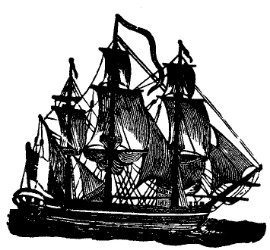
Woodcut of a 19th cent. barque
Magill (née Byers) from Cavan to Canada, 1832
The following PDF, much of it a literal transcription, is from the Magill family website. Its URL is provided in the PDF below. However, sadly the web address seems no longer to work.
The 1821 Cavan Census lists a William Magill at House No.5 in Derrylahan, Crosserlough, and the Magill website identifies William's wife Susannah as a Byers. The suggestion is that Susannah was possibly related to the Byers family living at House No.12 (see Page 5 of the 1821 Census PDF) in the same townland.
She may also be a relation of Joseph Byers, freeholder in 1825 at Derrylahan which was also tenanted by a Joseph Byers.

|
Re Susannah Magill nee Byers.pdf Size : 91.609 Kb Type : pdf |
Byers Emigration to USA
This next PDF makes a start at identifying Byers family members who made the cross-Atlantic journey in the 19th century.
Others may be found at the invaluable website of the Immigrant Ships Transcribers' Guild.


|
19th Cent Shipping Records re Byers and North America.pdf Size : 187.201 Kb Type : pdf |
Woodcut of a 19th cent. steamship.